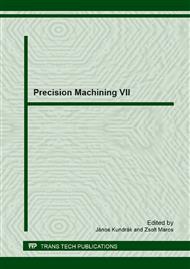p.235
p.241
p.247
p.255
p.261
p.266
p.272
p.281
p.287
Goodness Indicator and Technological Optimization of Honing
Abstract:
Optimisation of technological processes is an important field of research of machining processes. Honing process, its aim and results are affected more factors. Effectiveness is expressed by the following parameters: accuracy, surface roughness, complex surface quality (integrity),material removal rate, costs and productivity of the process. Developed method helps the technology planning and with the introduced new goodness indicator, investigates and corrects it. Optimization and minimization of costs can be ensured at given technological circumstances and technological parameters. With adjustment of the pressure (p) and the cutting speed (vc) economy of the process can be increased in the factory. Developed method can be applied for machining by other abrasive cutting tools. The paper summarizes new results of this theoretical and experimental research.
Info:
Periodical:
Pages:
261-265
Citation:
Online since:
October 2013
Authors:
Keywords:
Price:
Сopyright:
© 2014 Trans Tech Publications Ltd. All Rights Reserved
Share:
Citation:


